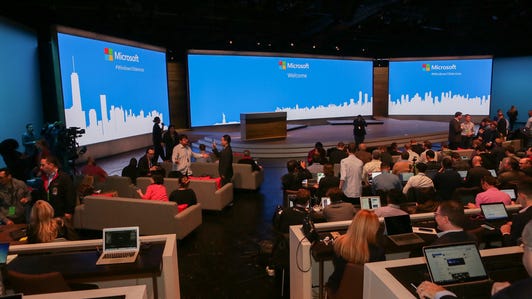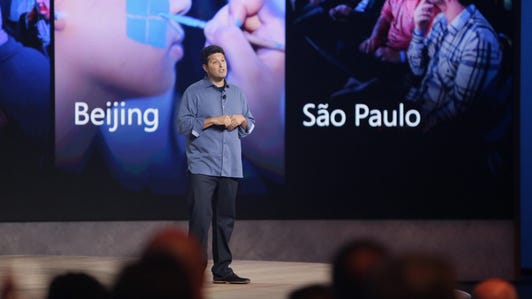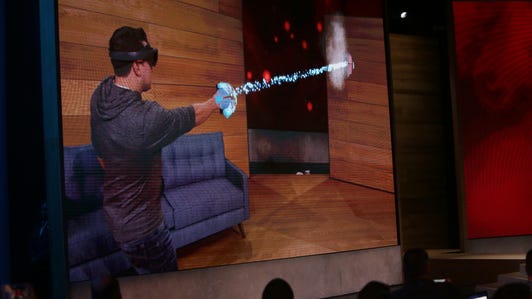
Sarah Tew/CNET
Most of Microsoft’s hardware announcements leaked prior to its big event — color me unsurprised. But for those of you who like to study the product-debut rituals of tech companies and couldn’t make it to the live-stream or live blog heralding its new wares designed to run Windows 10 and more, recap I will.
As expected, the company showed a new Surface Pro tablet, a couple of Lumia phones and another Microsoft Band fitness wearable. We also got a big surprise: a powerful, tiny convertible laptop dubbed the Surface Book. I am not a Microsoft fangirl, but I was impressed with what we saw today.
Microsoft unveils slew of Windows 10 devices and Surface Book (pictures)






It started with a barrage of happy-happy numbers: 110 million devices running Windows 10, 120 years of game play streamed, 1 billion questions posed to Cortana, 1.25 billion downloads from the Microsoft app store, a 400 percent increase in developer revenue since the Windows 10 upgrade, 650 billion pages viewed with the new Edge browser, and 8 million biz PCs running Windows 10.


Now playing:
Watch this:
Microsoft reveals first-ever laptop, Surface Book
2:34
Mobile: Surface Pro 4, Surface Book, Lumia 950 and 950XL
The Surface Pro 3 two-in-one hybrid tablet has gained surprising traction in some ways; for instance, over the past year, Adobe has been making a point of optimizing all its desktop applications to work on these Windows 10 touch devices, most recently bringing InDesign into the fold. As I expected, its applications got shout-outs as being pen-enabled during the demo, as did Pro-E CAD software.
Microsoft Surface Pro 4 tablet gets a powerful upgrade (pictures)






The new Surface Pro 4 improves on its 12-inch predecessor with a 12.3-inch display at 267 pixels per inch (5 megapixels) using Gorilla Glass 4, but retains the same footprint. Microsoft introduced PixelSense technology (a branding of its inking tech), supporting a stylus with 1,024 levels of pressure (that’s equivalent to Wacom’s consumer graphics tablets) with “best-in-class” palm detection and parallax compensation. The stylus attaches magnetically to the device, and uses a one-click launch, similar to the Adonit Jot Dash . The battery is rated to last a year.
It introduces a G5 chipset which enables real ink-like operation but intelligent interaction. It has different nibs (pen tips) which presumably deliver a different feel based on the type of inking you’re doing (painting, notetaking, and so on). Seriously, want.
It’s got a fingerprint sensor and “enterprise-level” facial recognition (Windows Hello), and it’s 8.4mm thick. The new Type cover has island-style keys on the keyboard with 1.3mm travel (also backward compatible) and a glass multitouch touchpad.
Other specs include up to 1TB of storage and up to 16GB of RAM, 30 percent faster than before and an 8-megapixel camera. There’s a docking station with four USB 3.0 ports, two 4K DisplayPort and Ethernet; it’s backwardly compatible with the 3. See how it compares with the iPad Pro, Macbook Air and Google Pixel C.
The Surface Pro 4 will start at $900 or AU$1,349 (converted, that’s £590 in the UK, official pricing and availability hasn’t been revealed yet) and will ship on October 26 or November 12 in Australia; preorders start October 7.
The Surface Book is Microsoft’s ‘ultimate laptop’ (pictures)






Microsoft also introduced a laptop version of the Surface, the Surface Book , which looks like a Surface with an attached keyboard. It has a 13.5-inch display that has a 6-megapixel resolution at 267ppi. It, too, incoporates PixelSense and has a quiet keyboard with backlit keys. It incorporates an nVidia GeForce for graphics processing (with GDDR5 memory), and has 12 hours of battery life. It’s targeted at people who need power — gamers, designers, developers and the like — and Microsoft claims it’s faster than the 13-inch MacBook Pro.
That attached keyboard? It pops off to turn the Book into a Surface, or flips around and folds down. The tech is called a Dynamic Fulcrum Hinge.
Related Links
- Microsoft’s Surface Studio: A desktop creation station with a magic dial
- Microsoft’s Surface Books get massive battery life boost
It weighs 1.6 pounds, is 7.7mm thick, and has a 3:2 aspect ratio (yay for pro photographers). It incorporates an Intel Core i7 current-generation processor, and the GPU is in the base/keyboard, so it only has GPU acceleration when connected.
Pricing starts at $1,499 or AU$2,299 and will be available on October 26 or, again, November 12 in Australia. (In the UK that works out to £985; again, availability wasn’t announced.) OK, want this too, but can’t afford.


Now playing:
Watch this:
Microsoft Lumia 950, 950 XL usher in Windows 10 for phones
1:27
As for Lumia phones, the most whiz-bang features of the 5.2-inch Lumia 950 ($550) sound like the quad-HD OELD display (1,440×2,560), USB Type-C (for fast charging) and Qi wireless charging. (Its US price converts to £360 or AU$770 in the UK and Australia, respectively. Microsoft didn’t mention pricing outside of the US yet.) It’s slated to incorporate 3GB of memory with 32GB of storage (plus microSD) and use a six-core Snapdragon 808 processor. The screen has 564-pixel-per-inch resolution and uses glance screen technology (it displays information without touching the screen).
The 5.7-inch 950XL ($650; converted that works out to £425 or AU$910) is similar to the 950, but uses an eight-core Snapdragon 810 processor.
The phones both have dual antennas so you’re never “holding it wrong,” and they use liquid cooling, probably because those processors run hot. The cameras have a 20MP sensor, triple LED RGB flash, updated optical image stabilization and a dedicated camera button. It supports 4K video. Plus it auto-uploads to the cloud.
They ship with the usual Microsoft apps onboard.
Microsoft Lumia 950 packs plenty of features (pictures)






Both will be available in November, — at least in the US for AT&T customers, along with a less-whizzy-but-cheaper quad-core Lumia 550 ($140, which works out to £90 or AU$195 at current rates). In Australia the 950 and 950 XL will be on sale “before Christmas”.
There’s also a Continuum dock that has a Type C input and three USB, HDMI and DisplayPort connectors; it will let your Surface automagically switch between tablet and desktop mode and display small screen content — like your phone screen — on larger screens while behaving like a desktop device and a mobile device. Windows 10 automatically scales the screen display. I have to say, it looks tempting.
Wearables: HoloLens, Microsoft Band


Now playing:
Watch this:
Microsoft Band returns with new design, curved screen
1:41
The next version of its fitness band gets some much-needed updates. For Microsoft Band, the company showed the typical video of people moving and sweating, looking at their wrists, and analyzing their bodies on a tablet.
While it has the same name as its predecessor, it’s been redesigned to be wider, more curved — the OLED screen uses durable Gorilla Glass 3. Cortana (Microsoft’s Siri) has been improved. Now you can track elevation; the Band adds an eleventh sensor to handle it.
It delivers constant access to all the data recorded by the Band, and integrates Microsoft Health to analyze it — it now supports VO2 Max, a common training metric for maximum oxygen intake.
Golfers can use it for shot detection — it knows whether you’re putting, driving or taking practice swings (and doesn’t count the latter). It uses accelerometer, gyroscope and vibration sensors to display information like distance to the green, and delivers an automatic scorecard. It works with iOS, Android and Windows devices. Lots of partnerships, including a shout-out to Lose It!
Preorders start today; it will be available on October 30 for $249, which converts to around around £165 or AU$350 .
A first look at the new Microsoft Band 2 (pictures)






The company also demoed “mixed reality” (its term for HoloLens’ augmented reality) in the form of Project X Ray, which turns every room in your house into a game level and has “wearable holograms” like weaponry. From the outside, it looks really cool.
Hololens has “the world’s first holographic processing unit”, and is untethered. It will become available to developers in the beginning of 2016 for $3,000 (currently that equates to about £2,000 or AU$4,200). They’re taking applications starting today.
See all of today’s Microsoft news.



